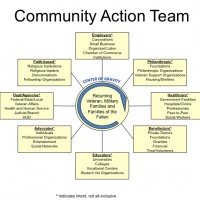Maybe you’ve heard of Jack Lengyel, the football and lacrosse coach who took over football duties at Marshall University after the plane carrying the team crashed, killing most of the coaches and players. After this tragedy, the community came together and connected with survivors and mourners to ensure they had the support and services they needed to move forward.
Today’s veterans returning from Iraq and Afghanistan – and their families – are like the Marshall faculty and students. Unlike Marshall, our veterans are scattered across the United States – and so are the resources available to them. The challenge lies in matching the Service member and his/her family with the local resource(s) available to them.
Based on his experiences at Marshall, Lengyel came up with a neat model to show the myriad support available to reintegrating soldiers and their families. The former coach calls this model the “Community Action Team” (CAT) and it served as the basis of a white paper I co-authored in late 2011.
A CAT is based on the recognition that there are just some things that government cannot provide. A CAT pulls in community services to assess the needs of veterans, families and families of the fallen – and then develops a plan to meet those needs.
A CAT identifies gaps in resources and strives to reduce duplication. Its goal is collective impact, not isolated impact. CATs do not require much financial support; rather, they just need leadership, encouragement and involvement. They bring innovation and flexibility because they are partner-centric networks.
The model looks incredibly complex but I assure you that CATs are already operating successfully in communities across the country. Our goal at Dixon Center is to collaborate with CATs to achieve even more positive results for our returning service members, veterans, their families, and the families of our fallen. So how do we do that?
For CATs, it’s about convening leaders and working with them in non-traditional ways to create a common agenda. Out in front of the curve is Anthony Hassan, Clinical Associate Professor and Director, University of Southern California Center for Innovation and Research on Veterans and Military Families.
Dr. Hassan is surveying veterans to get their first-hand input on what they need – not what we think they need. He uncovered something that should not be astonishing, but that hadn’t been previously considered very thoroughly. During his surveys, Dr. Hassan learned that carless veterans had a challenging time getting to school, work and medical facilities in automobile-centric Los Angeles. Public transit routes simply did not – and still don’t – map to where the vets live and the services that they require. Now many community based organizations are consolidating efforts in an attempt to collectively convince the City of Los Angeles to adjust its routes to better serve veterans. Dr. Hassan’s work is also a good example of corporate America collaborating with non-profits. Two full-time Deloitte employees work with Dr. Hassan to collect, track and report on his research.
Another CAT, the R4 Alliance, is just getting started. Fifteen organizations with shared purpose (including, but not limited to, the Sierra Club, Higher Ground, Project Sanctuary and Northeast Passage) have banded together to promote, improve and advocate for recreation services for military families. The R4 Alliance plans to take a leadership position and undertake research that will ultimately, it hopes, bolster public/private partnerships and influence healthcare providers to include recreation services as part of a standardized treatment plan.
Every day, about 1,000 Service members and their families transition from the military to civilian life. Are we effectively optimizing resources from civic, public and private sources through community-wide coordination? Are we fully mobilizing the community to be part of the solution? Do we have the right people in the room to build a common agenda?
How can YOU be a Community Action Team leader – or support one like Deloitte did? For more information you can look at Dixon Center’s toolkits or the Points of Light Institute’s Community Blueprint.

